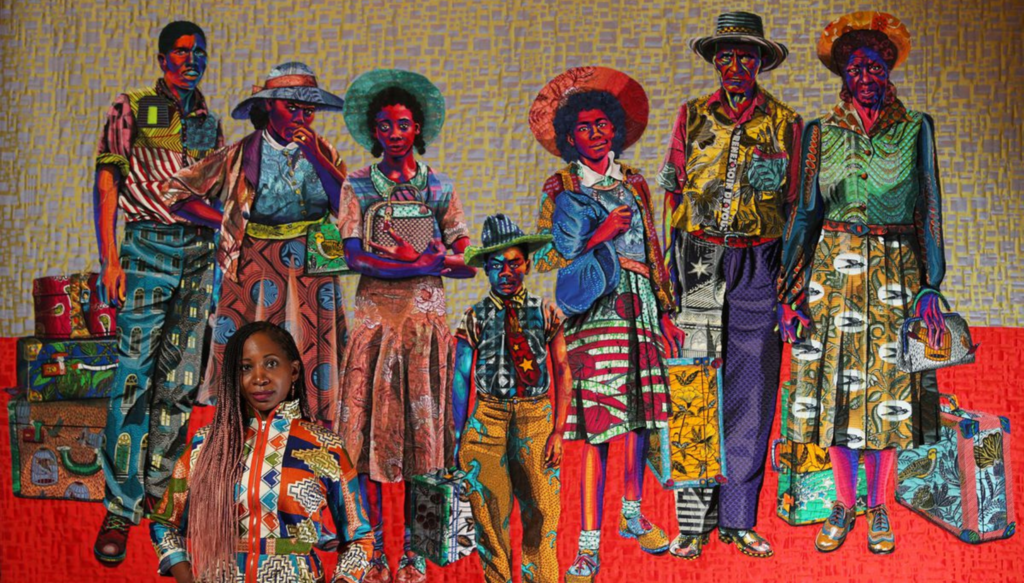Her work is stunning!
Newark artist Bisa Butler is using her “portrait quilts” to tell a new story, CBS News reports.
Butler is a former art teacher who is now being hailed as a modern day griot. Inspired by the dressmaking of her mother and grandmother, Butler began creating quilt art. Her vividly detailed portraits, all stitched with fabric, reimagine the lives of the real life subjects they portray.
The artist sources her material from real life photos, telling stories of those who have been forgotten or reimagining historical figures. The sepia toned picture of Harriet Tubman that she transformed into a beautiful portrait quilt, currently on display at the Smithsonian National Museum of African American History & Culture.
“When I find photos online or in the databases of Black people who are unnamed and unknown, I feel like I owe it to them to try to sort of ascertain what was their identity,” Butler said.
She has shown her work locally, curating beautiful pieces like the cover art for “Me Too” activist Tarana J. Burke’s new book Unbound, and getting pieces acquired at a few museums. Now, the Howard University alumna has reached a huge milestone in her career. Recently, she showcased her first solo exhibit at a major museum, The Art Institute of Chicago.
“Seeing my artwork at home and in my studio was one thing, but seeing it in this location is just completely mind blowing…When I first started making quilts, they were not considered fine art, they were considered craft…I think that historically quiltwork, craft work, has been marginalized because it was the work of women, and it was the work of people of color. It was considered like domestic labor,” Butler said.
She is now taking the opportunity to not only celebrate the craft but also the beauty of the Black lives they depict. Her life sized portraits are surreal, with Butler believing that each holds emotion because of the meticulousness of the process and the emotion she evokes into it. For those who view her work, Butler said there is a bit of an exchange between the portrait and the viewer.
“I love the idea that the images that I’m making are looking back out at me. So there’s like an intimacy there and it’s a confrontation too. I like the idea that there’s this dialogue between the subjects and the observers,” she said.
She said part of that conversation is also in the color, the rich hues of fabric she uses for each of her portrait quilts.
“I use the color as a way to communicate. If I think that somebody seemed to be more cool, more somber, I might use shades of blues and purples. If somebody appears to be a leader or appears to be more forceful, I’m going to use more intense color,” Butler added.
She currently works out of her home dining room in New Jersey, joking that the kitchen is the only place in her house that her family has full reign of. Her pieces take about six weeks on average to craft, her largest piece, “The Warmth Of Other Suns,” currently on display at the Newark Museum of Art, taking Butler a staggering seven months to finish. The quilt is 9 ft high and 12 ft wide, telling the story of Black families who migrated north from the south in search of better lives. Butler calls the quilt her baby and talks about how in her attempt to tell the story through her art, she also attempts to take care of her subjects.
“If you look at the original, he doesn’t have shoes,” Butler explained the differences between her portrait and the original photo.
“People wanted to travel in their very best so if he didn’t have shoes. it’s because they couldn’t afford them and that’s something that I like to give back,” Butler added.
Her work seeks to not only tell the story of who the people were, but also who they may have wanted to be.
“I want people to be able to look at my work and see the humanity in it and… for people who are not Black to understand that we are all human beings and we have the same wants and desires, loves and fears. And for Black people I want them to see themselves and realize that I recognize who you are and we are the same,” Butler said.
Currently, she’s working on a project for the Smithsonian centered around the Harlem Hellfighters, an all Black segregated infantry that helped the United States win World War I. The quilt will feature nine soldiers ranging in age from 19 to 33.
To purchase Butler’s “Portraits” book click, here.
We need you to keep telling our stories. Congratulations, Bisa.
Photo Courtesy of John J. Kim / Chicago Tribune




